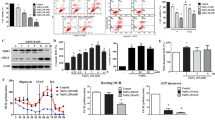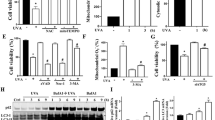Abstract
Purpose
To evaluate the effect of autophagy inducers on damage caused by vital dye in adult human RPE (ARPE) cells and in a rat model.
Methods
ARPE-19 cells were exposed to ICG or BBG (0.05 mg/ml) with rapamycin (200 nM) or metformin (2 mM) for 30 min and treated with or without 20 μM chloroquine (CQ) to identify the protein levels of LC3 and SQSTM1 by immunoblotting. In vivo study was performed by injecting 10 μl 0.05% ICG and 0.25% BBG into the subretinal space of the rat eyes, and/or co-treated them with metformin and rapamycin. The retinas were used to determine autophagy with the LC3-II level and apoptosis with terminal deoxynucleotidyl transferase-mediated dUTP-biotin nick-end labeling (TUNEL) assay.
Results
In this study, both ICG and BBG inhibited autophagy flux in adult human retinal pigment epithelium cells (ARPE-19), whereas only ICG consistently reduced autophagy in the retina of rats. Moreover, rapamycin and metformin induced autophagic flux in ARPE-19 cells and increased the LC3-II level in retinal tissues exposed to vital dyes. Both ICG and BBG increased apoptosis in the retina of rats. However, both rapamycin and metformin induced autophagy and reduced the apoptosis caused by vital dyes.
Conclusion
Taken together, these results suggest that rapamycin and metformin may diminish vital dye–induced retinal damage in vivo through activation of autophagy.




Similar content being viewed by others
References
Awad D, Wilinska J, Gousia D, Shi X, Eddous J, Muller A et al (2018) Toxicity and phototoxicity in human ARPE-19 retinal pigment epithelium cells of dyes commonly used in retinal surgery. Eur J Ophthalmol 28(4):433–440. https://doi.org/10.1177/1120672118766446
Tognetto D, De Giacinto C, D'Aloisio R, Papagno C, Pastore M, Zweyer M (2018) The combination of trypan blue and brilliant blue G-assisted vitrectomy for macular pucker: histopathological findings. Ophthalmologica. 239(2–3):167–175. https://doi.org/10.1159/000485986
Laperche Y, Oudea MC, Lostanlen D (1977) Toxic effects of indocyanine green on rat liver mitochondria. Toxicol Appl Pharmacol 41(2):377–387
Sheu S-J, Chen J-L, Bee Y-S, Chen Y-A, Lin S-H, Shu C-W (2017) Differential autophagic effects of vital dyes in retinal pigment epithelial ARPE-19 and photoreceptor 661W cells. PLoS One 12(3):e0174736-e. https://doi.org/10.1371/journal.pone.0174736
Liu PF, Chang HW, Cheng JS, Lee HP, Yen CY, Tsai WL, et al (2018). Map1lc3b and Sqstm1 modulated autophagy for tumorigenesis and prognosis in certain subsites of oral squamous cell carcinoma. J Clin Med. 7(12). doi: https://doi.org/10.3390/jcm7120478.
Klionsky DJ, Abdelmohsen K, Abe A, Abedin MJ, Abeliovich H, Acevedo Arozena A et al (2016) Guidelines for the use and interpretation of assays for monitoring autophagy (3rd edition). Autophagy 12(1):1–222. https://doi.org/10.1080/15548627.2015.1100356
Cheng JS, Tsai WL, Liu PF, Goan YG, Lin CW, Tseng HH et al (2019) The MAP3K7-mTOR axis promotes the proliferation and malignancy of hepatocellular carcinoma cells. Front Oncol 9:474. https://doi.org/10.3389/fonc.2019.00474
Maidana DE, Tsoka P, Tian B, Dib B, Matsumoto H, Kataoka K et al (2015) A novel ImageJ macro for automated cell death quantitation in the retina. Invest Ophthalmol Vis Sci 56(11):6701–6708. https://doi.org/10.1167/iovs.15-17599
Kivinen N (2018) The role of autophagy in age-related macular degeneration. Acta Ophthalmol 96(Suppl A110):1–50. https://doi.org/10.1111/aos.13753
Dehdashtian E, Mehrzadi S, Yousefi B, Hosseinzadeh A, Reiter RJ, Safa M et al (2018) Diabetic retinopathy pathogenesis and the ameliorating effects of melatonin; involvement of autophagy, inflammation and oxidative stress. Life Sci 193:20–33. https://doi.org/10.1016/j.lfs.2017.12.001
Frost LS, Mitchell CH, Boesze-Battaglia K (2014) Autophagy in the eye: implications for ocular cell health. Exp Eye Res 124:56–66. https://doi.org/10.1016/j.exer.2014.04.010
Balaiya S, Brar VS, Murthy RK, Chalam KV (2011) Comparative in vitro safety analysis of dyes for chromovitrectomy: indocyanine green, brilliant blue green, bromophenol blue, and infracyanine green. Retina. 31(6):1128–1136. https://doi.org/10.1097/IAE.0b013e3181fe543a
Luke M, Januschowski K, Beutel J, Luke C, Grisanti S, Peters S et al (2008) Electrophysiological effects of brilliant blue G in the model of the isolated perfused vertebrate retina. Graefes Arch Clin Exp Ophthalmol 246(6):817–822. https://doi.org/10.1007/s00417-007-0761-8
Kim YC, Guan KL (2015) mTOR: a pharmacologic target for autophagy regulation. J Clin Invest 125(1):25–32. https://doi.org/10.1172/JCI73939
Chang SH, Wu LS, Chiou MJ, Liu JR, Yu KH, Kuo CF et al (2014) Association of metformin with lower atrial fibrillation risk among patients with type 2 diabetes mellitus: a population-based dynamic cohort and in vitro studies. Cardiovasc Diabetol 13:123. https://doi.org/10.1186/s12933-014-0123-x
Wang GY, Bi YG, Liu XD, Zhao Y, Han JF, Wei M et al (2017) Autophagy was involved in the protective effect of metformin on hyperglycemia-induced cardiomyocyte apoptosis and Connexin43 downregulation in H9c2 cells. Int J Med Sci 14(7):698–704. https://doi.org/10.7150/ijms.19800
Funding
This study was funded by the Kaohsiung Veterans General Hospital (VGHKS106-109 and VGHKS107-131).
Author information
Authors and Affiliations
Corresponding author
Ethics declarations
Conflict of interest
The authors declare that they have no conflict of interest.
Ethical approval
All applicable international, national, and/or institutional guidelines for the care and use of animals were followed.
Additional information
Publisher’s note
Springer Nature remains neutral with regard to jurisdictional claims in published maps and institutional affiliations.
Rights and permissions
About this article
Cite this article
Shu, CW., Tsen, CL., Li, MS. et al. Metformin and rapamycin protect cells from vital dye–induced damage in retinal pigment epithelial cells and in vivo. Graefes Arch Clin Exp Ophthalmol 258, 557–564 (2020). https://doi.org/10.1007/s00417-019-04548-z
Received:
Revised:
Accepted:
Published:
Issue Date:
DOI: https://doi.org/10.1007/s00417-019-04548-z




